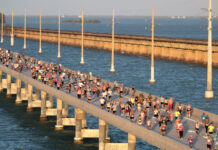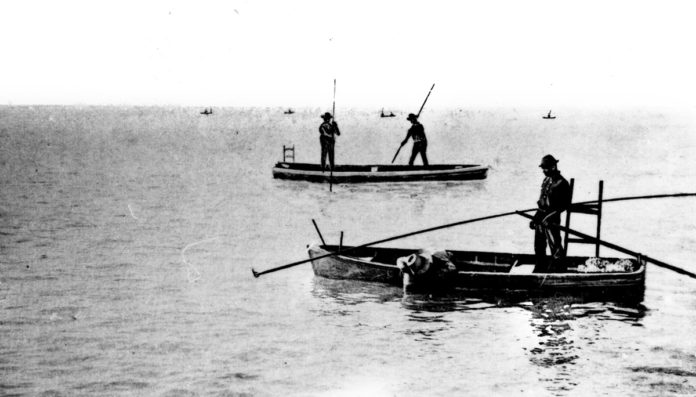It was May 22, 1914, when Captain Bell of the schooner Amelia wanted to get out of some high winds and set a course for the harbor at Key West. The Amelia was carrying a crew of 20.
When the anchor was dropped, Bell and six of his crew climbed into a launch and rowed to the docks. Bell and one of the crew walked into town. The others were left to watch the launch.
When Bell returned to where the crew members should have been waiting, they were gone. A mob of 500 had not only gathered but chased his men into a nearby store where two women brandishing pistols held the crowd at bay. Bell attempted to man his launch and row out of harm’s way, but members of the mob clawed at the boat and began ripping it apart. Bell jumped overboard and, while swimming away for his life, was fired upon. A bullet struck his left knee.
When the sheriff arrived, he pulled out his pistol and maybe even fired a shot up into the air. He managed to get Bell away from the mob and, for his protection, to the county jail. Not everyone would be safe that night. At about 11:30 p.m., 25 armed men climbed into the launch Key West and paddled out to the schooner Amelia where they boarded and quickly took control of the ship. At gunpoint, the crew members were forced from the schooner without the benefit of collecting their belongings or even clothes to wear.
The Key West mob robbed the Amelia of any valuables before they lit dynamite. The ship exploded and burned with one crew member, John Manis, still on board. It was not the only ship that was robbed and burned that day. The Edna Louise was attacked near the Marquesas Keys. In both cases, sponges were the cause of the violence, Conchs were the aggressors, and Greek sponge fishermen were the victims.
Why were the Conchs so pissed off? When they were sponge fishing, a mother ship towed a small fleet of skiffs behind it. The boat would anchor near a sponge bed, and two-person crews would operate the skiffs. In “A True Story of Some Eventful Years in Grandpa’s Life,” the memoir of Henry Perrine Jr., printed in 1885, he wrote of the sponge fishermen. “When the surface of the water is rough, the spongers are able to examine the bottom, as their boat glides slowly along, by using a small keg or box, in the bottom of which a pane of glass is securely fixed. By pressing this into the water below the ripples they can see the bottom almost as well as on a calm day. To obtain them, the spongers are provided with poles about twenty feet long which have stout two or three-pronged hooks upon their ends. By inserting these under the sponges they are detached from the rocks and brought to the surface.”
The man in the front of the boat was called a hooker. His job was to scan the bottom for sponges and then use the three-pronged curved hook to harvest the sponge. When he did, a little piece of the sponge was left behind that would grow and regenerate. The Greek sponge fishermen, however, did things a little bit differently.
The Greeks used two techniques when harvesting sponges. They hooked them from the shallows like the Conchs did but also donned hard-hat diving gear that included 50-pound metal boots that enabled them to walk along the ocean floor. There, they were able to pluck sponges from depths the Conchs could not reach. These deeper sponges were often better quality sponges. Using both techniques, the Greeks could gather up to four times as many sponges as their Conch counterparts.
What infuriated the Conchs, too, was the Greeks’ disregard for the sponge beds, which were damaged as they stomped along the bottom in their heavy diving boots. In a blow to the Greeks, the state passed a law in 1917 that prohibited diving for sponges except in designated areas, and the shallows surrounding the Florida Keys were not among those waters. Primarily operating out of Tarpon Springs, on the west coast of Florida, the Greek spongers made repeated attempts to relocate to South Florida and the Keys.
In 1927, Conch spongers went to Miami to protest an effort by the Greeks lobbying for the support of the Miami Chamber of Commerce to bring their business to Miami. A story about the Greeks’ efforts was published in the Aug. 20, 1927 Key West Citizen. “Miamians don’t know a conch from a sponge – all they want is to bring money to Miami. They’ve cleaned up the sponges of Tarpon Springs. Now they want to get into the Florida Bay, and know Miami is the nearest that they can hope to locate.”
Conch feelings for the Greeks did not temper over time. The April 14, 1930, edition of the Key West Citizen reprinted a story published in the Tarpon Springs News using the headline “Tarpon Springs Divers Warned From Key West.” It seems that a dozen or so Greek spongers from Tarpon Springs were considering moving their boats and their business to Key West. “It is well known that the average Key Wester has no love for a Greek sponger and look upon him as a rival and competition for his business.”
The Greek spongers never really landed in South Florida, and a sponge blight in the 1940s devastated the sponge beds for decades. For the Florida Keys, the sponge became another boom and bust industry. For Tarpon Springs, it left a more indelible mark on a community known still as the Sponge Capital of the World.



















